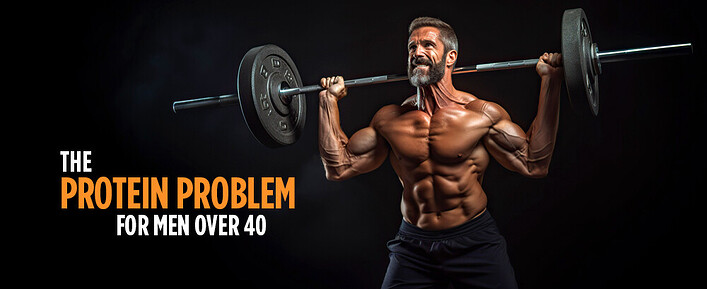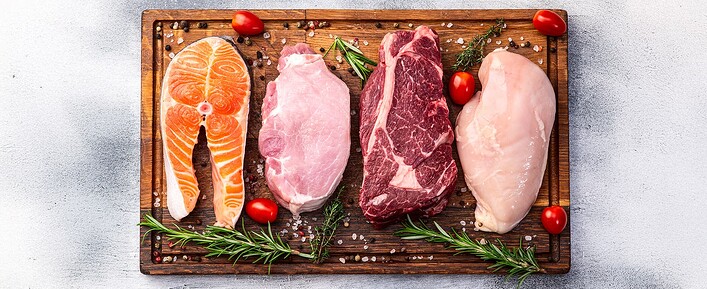The Protein Problem for Men Over 40
The older you get, the worse protein utilization becomes. Here's why and what to do about it.
Here's some crappy news: Sometime in your early 40s, your body's ability to build muscle starts to slowly decline. It's called age-related anabolic resistance, and it's all about muscle protein synthesis, the process by which your body creates new proteins to repair and grow muscle.
What causes it? Changes to muscle cell signaling (e.g., mTOR pathway), hormonal shifts (like reduced insulin sensitivity), and low-grade inflammation. The good news is that you're probably already doing a lot of things to prevent it or slow it down, like resistance training, avoiding excess fat gain, and reducing inflammation by taking your fish oil.
But age-related anabolic resistance also reduces your body's responsiveness to dietary protein. For example, the mTOR pathway becomes less sensitive to amino acids (especially leucine), reducing your muscle's anabolic response to protein. Aging muscles also have diminished blood flow, limiting post-meal amino acid delivery to muscle cells. Then there's increased splanchnic sequestration, where the gut and liver retain more amino acids, leaving fewer available for muscles.
If we don't start combating anabolic resistance in our 40s, we could become weak and fragile in our 50s or 60s. Recently, in Proceedings of the Nutrition Society, experts made an obvious recommendation: eat more protein as you age. However, they didn't have lifters and athletes in mind. Let's look at their conclusions, then apply them to folks like you who want to carry around a lot of muscle for a long time.
The Review
In the review published by the Cambridge University Press, the authors noted that older people (40+) require more protein to combat age-related anabolic resistance and support metabolic health and muscle maintenance.
The RDA of 0.8g/kg/day is designed to prevent deficiency, they said, but may not optimize muscle health in older adults. In short, they recommended at least 1.0g/kg/day and probably more.
Let's put some American numbers on that:
- RDA Recommendations: 0.36 g/lb/day. So, a 200-pound man should get 72 grams of protein daily.
- Review Recommendations: >0.45 g/lb/day. A 200-pound man should get 90 grams of protein daily, or more. They also suggested getting 25-30 grams of protein in every meal, assuming most people eat three squares a day. Using our 200-pound male example, that's only adding 18 grams of extra protein daily.
You're probably balking at these puny numbers. But, considering how nutrition "experts" have been downplaying protein intake for years, at least it's a step in the right direction. And we can learn a few things.
Applications for Lifters
The authors of the review did highlight some important stuff, like how age-related anabolic resistance starts early, in our 40s, and gets worse over time if we don't take precautions. This could lead to sarcopenia.
It's also interesting to know that aging bodies don't "use" protein as efficiently as they used to. The solution to the protein-utilization problem is simple: get even more protein than you used to, and maybe choose better protein/amino sources, such as these:
- Casein hydrolysate – the most anabolic protein – is already broken down into highly structured peptides that jam themselves directly into muscle tissue for nearly instant absorption and utilization. Age-related anabolic resistance can't stop it. It's estimated that 20 grams of casein hydrolysate triggers more muscle growth than 30 or 40 grams of conventional protein. Each serving of MAG-10 (Buy at Amazon) contains 20 grams of PeptoPro casein hydrolysate highly structured peptides. Peptopro is a specific form of casein hydrolysate optimized for sports performance.
- Leucine is the master amino acid for building muscle, but it's also muscle-sparing and fat-burning. It even increases insulin sensitivity, one of the "bad guys" associated with anabolic resistance. The average non-lifter can get by with around 3 grams of leucine daily, but lifters need 5 grams or more. Most meats contain 2.5 to 3.5 grams of leucine per 100-gram serving, and our workout drink, Surge Performance Fuel (Buy at Amazon), contains 5 grams of leucine per serving.
- Whey protein isolate and casein are also good sources of leucine. Thirty grams of whey isolate contains approximately 3 grams of leucine. Casein is also a complete protein, containing all the essential amino acids, including leucine. Look for a general-use protein powder containing both, like MD Protein (Buy at Amazon).
As a rule of thumb, consider bumping up your protein intake by at least 20 grams a day after age 40.
Reference
- Morgan, et al. Dietary protein recommendations to support healthy muscle ageing in the 21st century and beyond: considerations and future directions. Proceedings of the Nutrition Society, Cambridge University Press: 11 October 2023.





